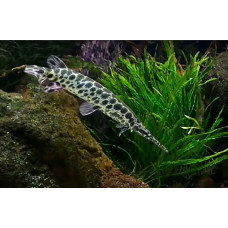Lepisosteidae is a family of fishes of the order Lepisosteiformes. Arrow-shaped body with an elongated snout, covered with diamond-shaped ganond scales. The dorsal fin is carried backward and lies above the anal fin. The mouth is large, armed with powerful teeth. The axial skeleton is bony. There are 2 genera (Lepisosteidae and shell pike) and 7 species. Body length from 75 cm to 3-4 m, as an exception up to 6 m. They inhabit freshwater bodies of North and Central America and Cuba. Ambush predators. Non-target species.
Body of Lepisosteidae elongate, covered with strong ganoid scales, jaws elongate with long sharp teeth. The caudal fin is shortened heterocercal: the supporting elements of the rays (hypuralia) are supported by the upwardly bent end of the vertebral column, the dorsal fin is located close to the tail. There are approximately 50-65 scales in the lateral line. Their blood-vessel-rich swim bladder can function as a lung, so Lepisosteidae often surface to breathe fresh air, more often doing so in standing or warm water where oxygen concentrations are low. As a result, they are quite hardy and can live in conditions intolerable to most other fish. All Lepisosteidae are relatively large fish: the largest species Atractosteus spatula in some cases reaches a length of 4.5 meters. Even small species, such as Lepisosteus oculatus, usually reach 60 cm as adults, sometimes more.
All modern Lepisosteidae inhabit rivers and freshwater lakes of North and Central America. Their range extends northward to Quebec, the Great Lakes, and the upper Mississippi River, and southward to Costa Rica, southwestern Cuba, and Pinos Island. They do not occur west of the Rocky Mountains. Although Lepisosteidae are typical freshwater fishes, individual species of them often enter brackish waters and even waters with marine salinity, but they never breed in these waters.
Lepisosteidae are sedentary fish and spend most of their time frozen in the water column. However, when grabbing prey, they make lightning-fast throws, and if necessary, they can move short distances with very high speed. In summer, they often rise to the surface to breathe air. In this case, the end of the snout sticks out of the water and the exhaled air is ejected with a peculiar noise. In winter, Lepisosteidae go to deep places of water bodies, where they stand motionless at the bottom, almost completely stopped feeding.
The main food of Lepisosteidae is fish. They hunt by stalking their prey from behind cover. Like crocodiles, which they resemble in their appearance, Lepisosteidae with their powerful jaws grab prey across the body and can hold it in this position for a long time before finally swallowing it.
Spawn only in fresh waters. Spawning is turbulent and short-lived. Thus, for example, at the latitude of New York about lasts from mid-May to mid-June. During spawning Lepisosteidae, like common pike (which they resemble in appearance), go to a warm shallow water, each female is accompanied by one to four males. Spawning fish do not care about the offspring and quickly leave the spawning ground. Sticky greenish-colored eggs are attached to the substrate. Incubation period is short. Upon emergence from the eggs, the larvae are attached to rocks or algae with the help of special suction cups located on the lower front part of the snout. As soon as the yolk sac they resorb, they go to an active diet of small crustaceans, mosquito larvae, etc., and after reaching 4-5 cm in length turn into real predators, rushing to the young of other fish. By this time, the larvae have fully developed pectoral fins and tail filament, which are in continuous movement. The caudal filament, which is formed at the end of the upwardly bent spine, is later completely reduced. Males become sexually mature earlier than females and are smaller in size. Individual species reach a length of 3-4 meters and a weight of over 150 kg. For humans, these ferocious predators are not dangerous: disturbed by a swimmer or fisherman fish escapes and goes to the depths. In fishing grounds, Lepisosteidae cause significant damage by tearing nets and dragging away hooked fish.
The meat of Lepisosteidae is edible, sometimes sold in stores, but the eggs are poisonous. Several species are kept in aquariums.
Lepisosteidae
Tags: lepisosteidae



